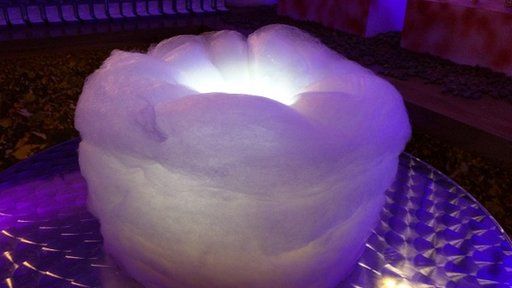Is this the sweetshop of the future?
- Published

I've been to a sweet shop of the future and I'm afraid I have got some bad news.
The confectionery looks exquisite but the portions are decidedly meagre.
That's because cacao, the main ingredient of chocolate, could become more expensive than gold. Water could also be at a premium, and sugar, as we already know, is unavoidably bad for your health.
So, instead of eating it, why not use it to light up your living room or give your jewellery an extra bit of sparkle?
Willy Wonka-esque candy floss lamps and edible diamonds were just some of the futuristic creations developed by self-proclaimed "food futurologist" Morgaine Gaye and award-winning British chocolatier Paul A Young at Future Fest, an event held in London this month.
They looked at the factors they thought likely to alter the landscape of confectionery manufacturing, and predicted that sweets as we know them were going to change dramatically over the next 20 years and beyond.
"My whole business is about being handmade, but we are going to rely on machines more," said Mr Young, former head pastry chef for celebrity chef Marco Pierre White.
"I have to open up to saying: 'What can a 3D printer do?'
"I want every home to have a 3D printer for making chocolate dessert."
Nano rings - intricate chocolate lattices that can only be created by machine - were created as a suggestion of an upmarket chocolate that looked elaborate but was very small in terms of portion size.
"Chocolate will have more decoration, but it's already getting smaller," Mr Young said.
"In 20 years you will pay £10 for a small bar."
Processed sugar will be replaced by natural alternatives, the pair suggested.
They had created tiny "micro disruption" bars made out of coconut sugar and a tiny amount of cacao.
They also invented "edible diamonds", made out of isomalt, a sugar substitute already widely used by the food industry.
"It's a very clear crystal, it doesn't go sticky," said Mr Young.
"You could make a whole window out of it."
Water woes
Brazil's most populous states - Sao Paulo, Rio de Janeiro and Minas Gerais - are currently experiencing their worst droughts in 85 years.
Western Australia has seen its rainwater reserves fall by about 80% over the last 15 years.
And the International Committee of the Red Cross is also warning about a "water catastrophe" in the Middle East.
All these places are producers of chocolate.
One thousand seven hundred litres of water are required to produce a 100g (3.5oz) bar of chocolate - including the water required to grow the cocoa plants - according to the Water Footprint Network.
Mr Young and Dr Gaye warn environmental issues could force significant changes to confectionery.
To tackle the potential threat, the pair have created small sweet treats they call Thirst Globes.
These chocolate balls, around the size of a Ferrero Rocher, contain unusual flavours of dehydrated fillings such as apple and carrot, or beetroot and tangerine, which turn into a velvety soft texture when they mix with the saliva in your mouth.
"We already know water supply and quality is an issue," said Dr Gaye.
"We wanted to create something with texture and flavour - that was also filling."
'Emotional link'
However, before you rush out in a panic and start stockpiling king-sized Easter eggs, not every confectioner shares this vision of diminishing sweet treats.
US-owned sweet maker Cadbury said such radical changes would be difficult for mass market consumers to accept.
"Chocolate is actually a fairly traditional food," said a spokesman.
"We spend a lot of time testing and tasting to ensure that the emotional link that you have built up with a favourite over many years is not broken."
Social trends would also continue to play an important role in the development of new sweets, the firm added.
"Chocolate companies will continue to explore ways in which their product is relevant to the lifestyles of today's consumers," it told the BBC.
"So, for example, a product like [the miniature chocolate assortment] Heroes would not have been relevant a generation ago because people gave chocolate much more formally.
"Today, we turn up at people's homes and share out food in a casual manner that would have been unthinkable to our parents' generation."
- Published18 March 2015
- Published23 March 2015
- Published28 February 2014
- Published30 December 2013